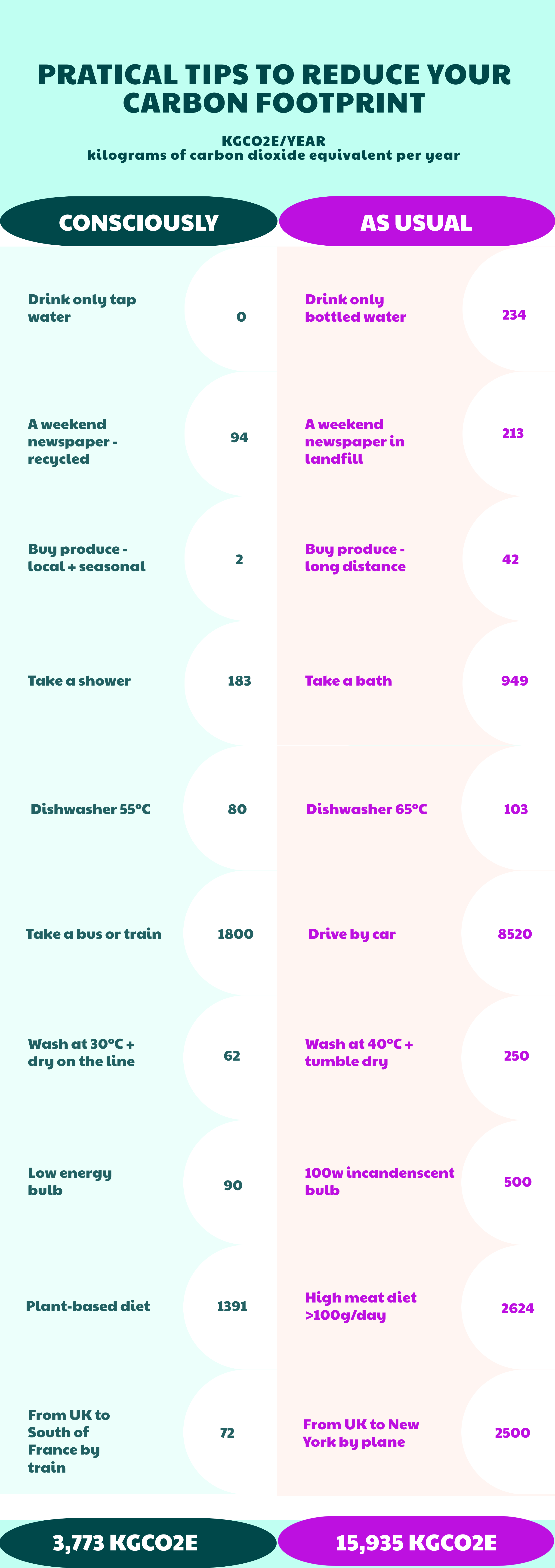
reduce your carbon footprint
Table of Contents
ToggleCarbon Footprint: how to reduce it?
Carbon footprint refers to the total greenhouse gas (GHG) emissions produced by an individual or organization. These emissions are primarily caused by human activities, such as burning fossil fuels for energy, transportation, and industrial processes. GHGs trap heat in the atmosphere, contributing to climate change and its associated impacts, such as rising sea levels, extreme weather events, and disruptions to ecosystems.
Reducing our carbon footprint is crucial to mitigate climate change and protect the environment. Here are some effective ways to reduce your individual carbon footprint:

As we can see, the difference between the two results is quite important. More in detail we can see what can we do better.
1.Transition to Renewable Energy:
A significant portion of our carbon emissions comes from energy production, particularly from the burning of fossil fuels like coal, oil, and natural gas. Switching to renewable energy sources, such as solar, wind, geothermal, and hydropower, can significantly reduce your carbon footprint.
2. Improve Energy Efficiency
Energy efficiency involves using less energy to achieve the same level of service or comfort. This can be achieved through various measures, such as:
– Using energy-efficient appliances and lighting.
– Installing insulation and weatherization measures to reduce heat loss in buildings.
– Adopting smart home technologies to optimize energy use.
– Practicing energy-saving habits, such as turning off lights and electronics when not in use, and adjusting thermostat settings.
3. Reduce Transportation Emissions
Transportation is a major contributor to GHG emissions, particularly from personal vehicles. Reducing your reliance on cars can significantly lower your carbon footprint. Consider these options:
– Walk, cycle, or use public transportation whenever possible.
– Carpool or vanpool for commuting or long trips.
– Consider switching to a hybrid or electric vehicle when purchasing a new car.
Support policies that promote sustainable transportation infrastructure and public transit options.
4. Adopt Sustainable Food Practices
The food we consume contributes to GHG emissions through agricultural practices, transportation, and food waste. Sustainable food choices can reduce your carbon footprint:
– Eat less meat, especially beef and lamb, as meat production is a significant source of emissions.
– Choose locally grown, seasonal produce to reduce transportation emissions associated with food.
– Reduce food waste by planning meals, storing food properly, and composting food scraps.
5. Conscious Consumption and Waste Reduction
Our consumption habits and waste disposal practices also contribute to GHG emissions. To reduce your carbon footprint:
– Buy less stuff, especially unnecessary items.
– Choose durable, long-lasting products that reduce the need for frequent replacements.
– Repair and reuse items whenever possible, instead of discarding them.
– Practice proper waste management, including recycling, composting, and avoiding single-use plastics.
6. Support Sustainable Businesses
Choose to support businesses that prioritize sustainability and environmental responsibility. These businesses often adopt eco-friendly practices, such as using renewable energy, reducing waste, and sourcing sustainable materials.
7. Advocate for Climate Action
Individual actions are important, but collective action is crucial to drive systemic change. Engage with your community, local government, and elected officials to advocate for policies that promote renewable energy, sustainable practices, and climate action.
Reducing our carbon footprint requires a multifaceted approach that involves individual lifestyle changes, conscious consumption habits, and support for sustainable practices and policies. By making informed choices and taking action, we can collectively mitigate climate change and create a more sustainable future.





